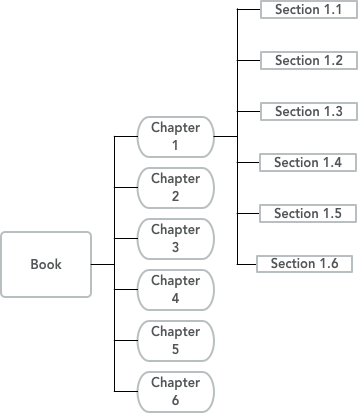Structuring Your Resource
Textbooks and other course materials are complex publications. They need to cover a large body of knowledge in a structured way, using format and design elements to help the learner better understand the subject. Consistency is key! When your students know what to expect from each section, they can more easily navigate the content and will have an easier time learning. To understand how best to structure a textbook, let’s first take a look at the anatomy of a textbook:
Textbook Parts
A textbook is much like a book in terms of its three basic parts: 1) front matter, 2) text and 3) back matter.
The front matter is the content you find before the first chapter. It often includes the title of the work and information about the edition, publisher and copyright (e.g., a Creative Commons license). It may also include acknowledgements, dedications, a foreword and a table of contents. Other elements may also introduce the reader to the subject. For example, a history book may include a timeline of events.
The front matter is also a good place to include information about the author(s), in the form of biographical information, requests for adoption notification, peer review methodology, and instructions for submitting errata and feedback.
The text is the body of the book. It’s typically divided into chapters at a minimum. Textbooks are often organized further through the implementation of consistent pedagogical elements (a concept explored later in this section).
The back matter is the content you find after the chapters that often supports the text. For example, citations, image credits, appendixes, a glossary, and an index.
Now that we understand the major component parts of a textbook, let’s explore how using structural elements can help us organize content within these parts.
Textbook Structure
Authors and collaborators often start a project by determining a textbook’s structure, or a consistent way to organize content. Textbook structure may take a variety of forms depending on the course content, learning context, pedagogical approach and other factors.
Below are three typical textbook structures.
Example 1: Book– Chapter– Section
Example 2: Book– Chapter– Section– Subsection
Example 3: Book– Unit– Chapter– Section–Subsection
For our example, let’s say an author decides to organize their book according to example 1: Book–Chapter–Section. The book structure would look something like this (showing chapter one sections only):

Often a book’s structure is described using terms like “parts” or “levels”.
It may be useful to map the book’s structure, thereby creating a basic outline, before beginning to write.
Structuring Resources in Other Formats
If you’re not creating a traditional textbook and are opting for a different format, such as a Canvas course, a video series, or a website, you can still use these principles to think about organizing your content. For a website, consider nested pages for particular content areas. For a video series, use transitions and title cards to divide your video into sections to guide the user through your content.
Key Takeaways
- Decisions about structure and hierarchy are often the step in planning an OER project. You should consider how you want to group and organize your content.
- Textbooks generally follow a format involving three basic parts: front matter, text, and back matter. Within the text, you might have parts, chapters, sections, or subsections to further group content.
- If you’re structuring your resource in a format other than a textbook such as a video series, these are still valuable principles that can be utilized while organizing your content.
Sources
Schneider, D. K. (2008, September 3). Textbook writing tutorial. Retrieved March 04, 2018, from http://edutechwiki.unige.ch/en/Textbook_writing_tutorial.
This chapter was adapted from Creating and Editing Open Educational Resources by Beth South, licensed CC BY 4.0

